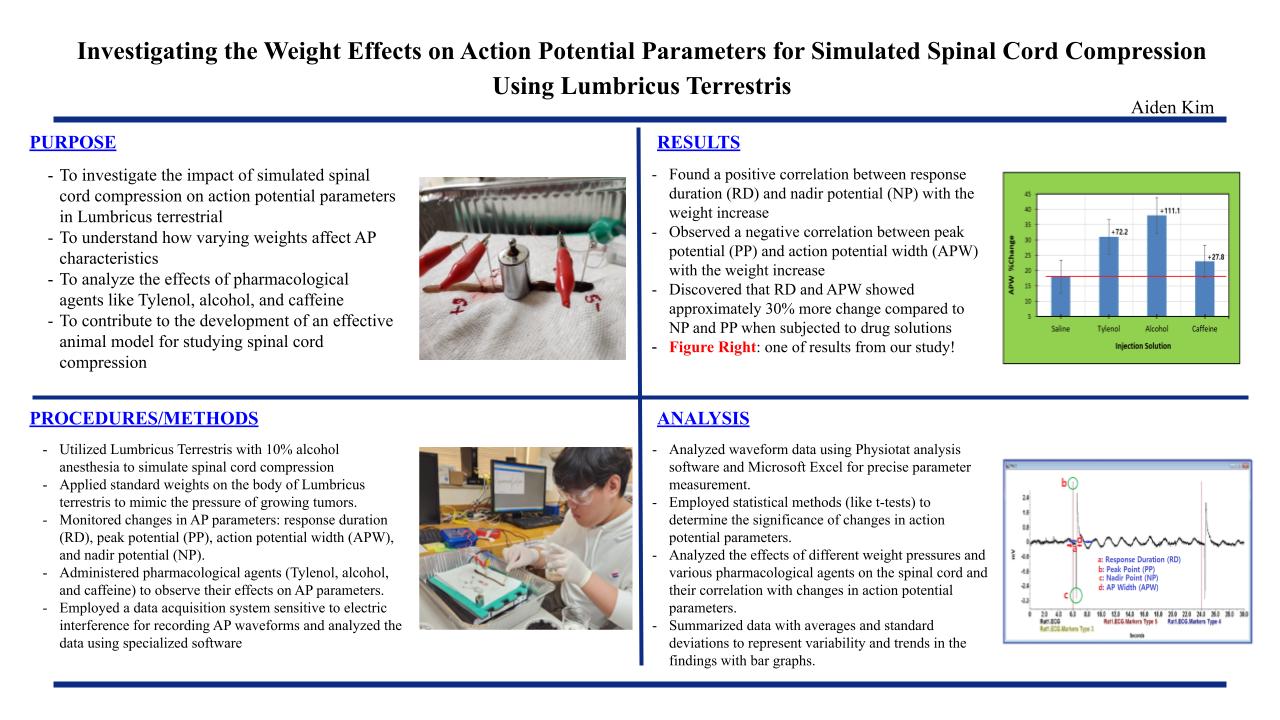Investigating the Pharmacological Effects on Action Potential Parameter Change by Simulated Spinal Cord Compression with Lumbricus Terrestris
Abstract:
Bibliography/Citations:
Egri, Csilla, and Peter C Ruben. Action Potentials: Generation and Propagation, John Wiley & Sons, Ltd., 2012, www.esalq.usp.br/lepse/imgs/conteudo_thumb/Action-Potentials-Generation-and-propagation.pdf.
Experiment An-4: Action Potentials in Earthworms - Iworx Systems Inc, iworx.com/documents/LabExercises/ActionPotentials-Worm.pdf. Accessed 3 Oct. 2023.
Fletcher, Allan. Action Potential: Generation and Propagation, Elsevier Ltd., 2016, daneshyari.com/article/preview/2742105.pdf.
Kladt, Nikolay, et al. “Teaching Basic Neurophysiology Using Intact Earthworms.” Journal of Undergraduate Neuroscience Education : JUNE : A Publication of FUN, Faculty for Undergraduate Neuroscience, U.S. National Library of Medicine, 2010, www.ncbi.nlm.nih.gov/pmc/articles/PMC3597421/.
Shannon, Kyle M, et al. “Portable Conduction Velocity Experiments Using Earthworms for the College and High School Neuroscience Teaching Laboratory.” Advances in Physiology Education, U.S. National Library of Medicine, Mar. 2014, www.ncbi.nlm.nih.gov/pmc/articles/PMC4116350/?report=printable.
White, John A. Scientific Computing and Imaging Institute, Boston University, 2002, www.sci.utah.edu/~macleod/bioen/be6003/notes/W09-encyc_human_brain_00.pdf.
Additional Project Information
Project files
Research Plan:
Procedures
Materials:
Water, 10% ethyl alcohol solution, telemetric device with recording electrodes, dissecting pins, electrodes, transmitter, ruler, 500mL beakers, 1 mL tuberculin syringes, 26G needles, foam pad, earthworm (Lumbricus terrestris), stopwatches, electrical stimulator, Tylenol, alcohol, standard weights, magnets, Q-tips, PC computers with telemetry.
L. terrestris Handling and Anesthesia Procedures:
- Two 500 ml beakers will be filled with 100mL solution of 10% alcohol and the other with 100 ml water for rinsing the L. terrestris. After removing dirt in the water, the earthworm will be weighed.
- The earthworm will then be placed in the 10% alcohol solution immediately after a stopwatch starts while anesthetic effects are carefully observed. When no wiggling movement is observed from the earthworm in the alcohol, it will be placed on a paper towel on foam padding located on the telemetric receiver. The earthworm will be stretched to its full length and pinned carefully at the location of electrodes for electrical stimulation.
- After anesthesia, the animal will be moved onto the experimental bed and placed over the telemetric receiver. Two metal pins will be carefully pierced through the skin at the head and tail ends of the earthworm. These two pins will be used for electrical stimulation. A positive electrode from the recording telemetric transmitter will be pierced 1 centimeter anterior to the pin near the head, while the negative wire will be pierced 1 posterior to the pin near the tail end.
- The weights will be placed on the spins as scheduled prior to the study.
- An electrical stimulator will be used to deliver stimulations of 50mV, 100mV, and 150mV to the stimulator pins, while electrical data of action potentials are saved with the real-time display on the monitor. The weights will be placed on the spins as scheduled before the study.
- 100 uL intervals of the substance will be injected into the worm with a syringe and needle in between the two recording electrodes, avoiding the intestine. The injection spot will be lightly pressed on to encourage diffusion of the substance. The earthworm will be left alone for 5 minutes before electrical stimuli tests are performed.
Risk Assessment
- No specific risk is raised.
- All procedures will be conducted using appropriate personal protective equipment (PPE), including disposable gloves, safety goggles, and masks. Special attention will be given to prevent needle punctures, including the use of double gloves.
Data Analysis
Data analysis will be performed using analysis software, using plot points of the AP graphs for each action potential to record results. The consistency of data and the experimental setup will be first assessed, followed by the implications of changes in certain parameters during drug administration. A shorter wave width from the same stimuli after drug administration may imply drug excitability. Data tables with the averages and standard deviations for each parameter of all recorded action potentials will be created. Charts for the averages of each parameter and volume of injection will also be created. The data will be analyzed by noting the trendline and parameter changes with respect to the baseline values and the expected effects/outcomes of certain types of injections in terms of action potential propagation.

